No products in the cart.
April 16, 2025
Sandra Stops tells stories through images – quietly, sincerely, and with great sensitivity. Her work often emerges intuitively and shows that clarity and depth don’t have to be mutually exclusive.
Her work invites you to pause, without ever being intrusive. It’s less about grand gestures and more about what resonates between the lines.
Name
Hello, my name is Sandra Stops.
Where do you live?
My home base is Berlin.
What kind of art/creativity do you mainly pursue?
I work as a freelance painter.
Did you complete any formal training, or are you self-taught?
I’ve acquired my skills and techniques mostly through my own initiative, lots of experimentation, and intensive self-study – without relying on a formal, institutional art education. Over the years, I’ve attended many courses and have worked more extensively with individual teachers from time to time.
Where can people see your work? Do you have a website or social media profiles you'd like to share?
My work can be explored on my website and on Instagram. I also regularly open up my studio to visitors – this year on 4 May 2025, from 2 to 6 pm – and I take part in exhibitions from time to time. My most recent solo exhibition in Berlin just wrapped up. If you're interested in seeing my work, I recommend following me – the best way is through my newsletter, where I share all important updates and dates.
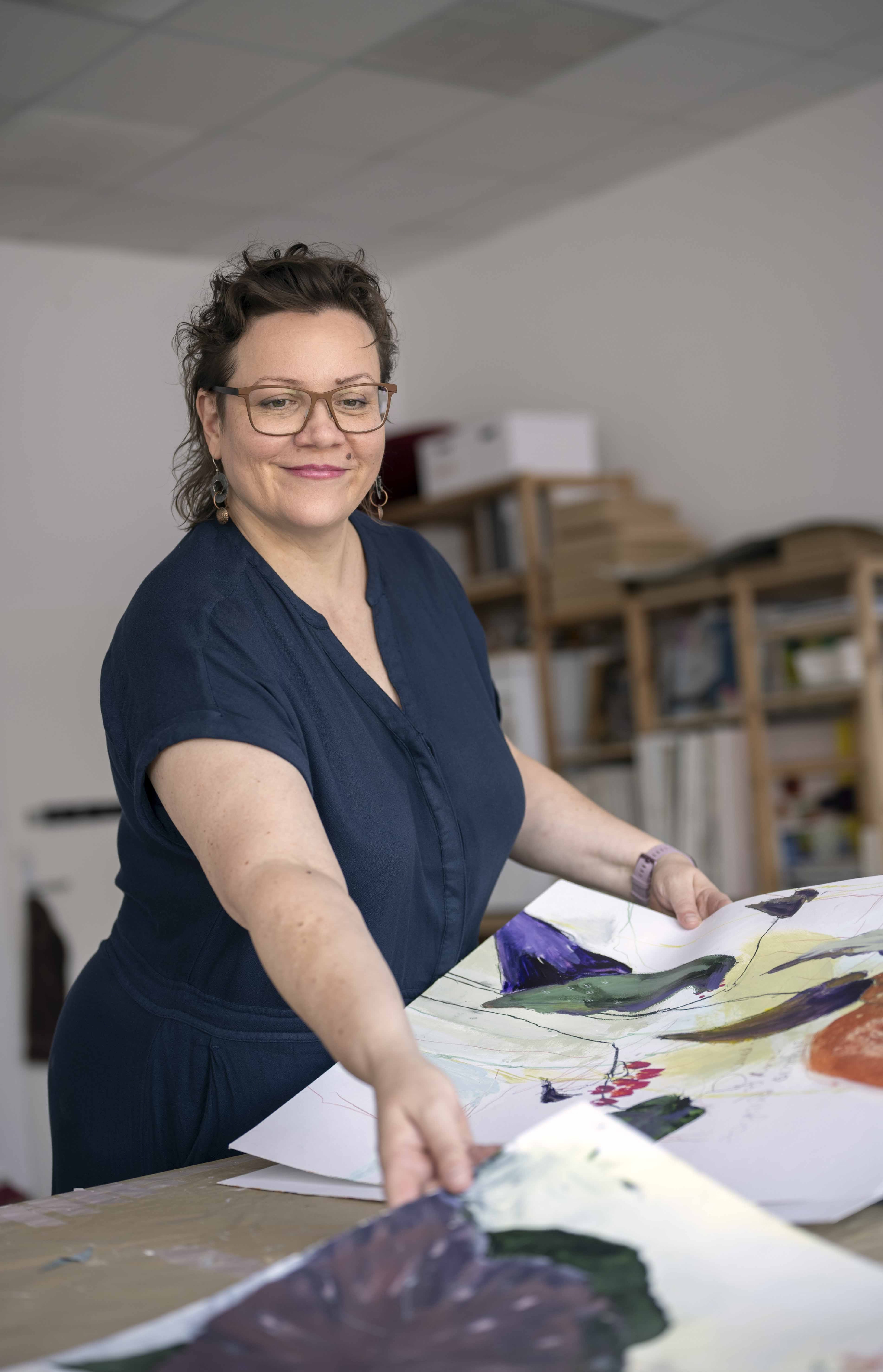
Artist Sandra Stops | Photo: Paula Lüdke 2024
My creative journey started early – I was always drawing and painting, even during school lessons, often because I felt underchallenged. Drawing kept me engaged. When I was 17, I saw the film Le Mystère Picasso by Clouzot and instantly knew: that’s what I want to do. I want to paint like Picasso – with his playful spirit, curiosity, and storytelling flair. My first portraits even featured his bald head and that charming smile.
In a way, everything and nothing inspires me. I love observing people, diving into stories, and taking things in deeply. There’s a quote by Rilke that fits perfectly: “Most people don’t know how beautiful the world is and how much splendour is revealed in the tiniest things – in a flower, a stone, the bark of a tree or a birch leaf…” I move through the world with all my senses switched on – smells can carry you away, sounds send you on a journey, the eyes wander, the body feels... Movement and dance energise, music lifts the spirit or gives you a sense of being held, singing connects. Even good questions can be a source of inspiration – when they’re the right kind.

Art Studio
Hmm, I’ve built up a pretty good collection of art books at home and in my studio – some by well-known artists, others more like lucky discoveries. I keep coming back to the works of Helene Schjerfbeck, Paula Modersohn-Becker, and Joan Mitchell. But I also find the Fauves fascinating, along with Cézanne, Monet, Delaunay, Gentileschi, and Lotte Laserstein. Among contemporary artists, I’d currently name Jenny Saville, but also Chantal Joffe and Elizabeth Peyton. I love going to exhibitions and museums, staying open and curious about what’s on display – and I always hope there are plenty of works by women artists among them.

In the Studio
My creative process is an open one. I usually start with a theme, an idea, or a question in mind – but not a concrete image. The motifs evolve as the process unfolds. I experiment a lot, because I try to find a unique visual language for each topic. That works best when I keep trying new things, break away from familiar paths, and reflect continuously on both the process and the work itself. Spending a lot of time just looking at the pieces is an essential part of it.
Ideally, I get to work on a theme for several days in a row with full focus. And if I also have some exchange with other creatives during that time, it’s pretty much perfect. I commit to the process, even if that means there might be nothing “useful” in the end. There’s always a bit of risk involved.

Work in sketchbook | Photo: Paula Lüdke
I usually work on thick paper because it can withstand more intense handling. Especially at the beginning of a new series, paper is the better medium for me – it’s flat, stackable, and available in many formats. Stretched canvases only come into play later in the process. I use acrylic paint and brushes, watercolour pencils, graphite, and often self-made “brushes” – or simply my hands. At the same time, I’m open to other materials: I find marble dust exciting, and scalpels too... I’m constantly discovering new things and feel like I’m far from the end of that journey.
I’d say it’s usually my current series that’s closest to my heart. My major solo exhibition An den Adern des Lichts in Berlin just came to a close, and I had many conversations with visitors. Openings are a bit like film premieres – the film has long been finished by the time the promotion starts. The comparison doesn’t fully hold, of course – I’m not a blockbuster artist – but talking about your own work is simply part of it. Mentally, though, I’m often already somewhere else – immersed in my current projects.
It gets really exciting when different works are being shown simultaneously in different exhibitions…
That said, there are a few series that mean a lot to me – well, actually three: Unveiled Fury, which deals with female anger; a series about the comfort of tender gestures; and my most recent pieces, which explore physicality, the act of grasping (in both senses), and questions of identity.
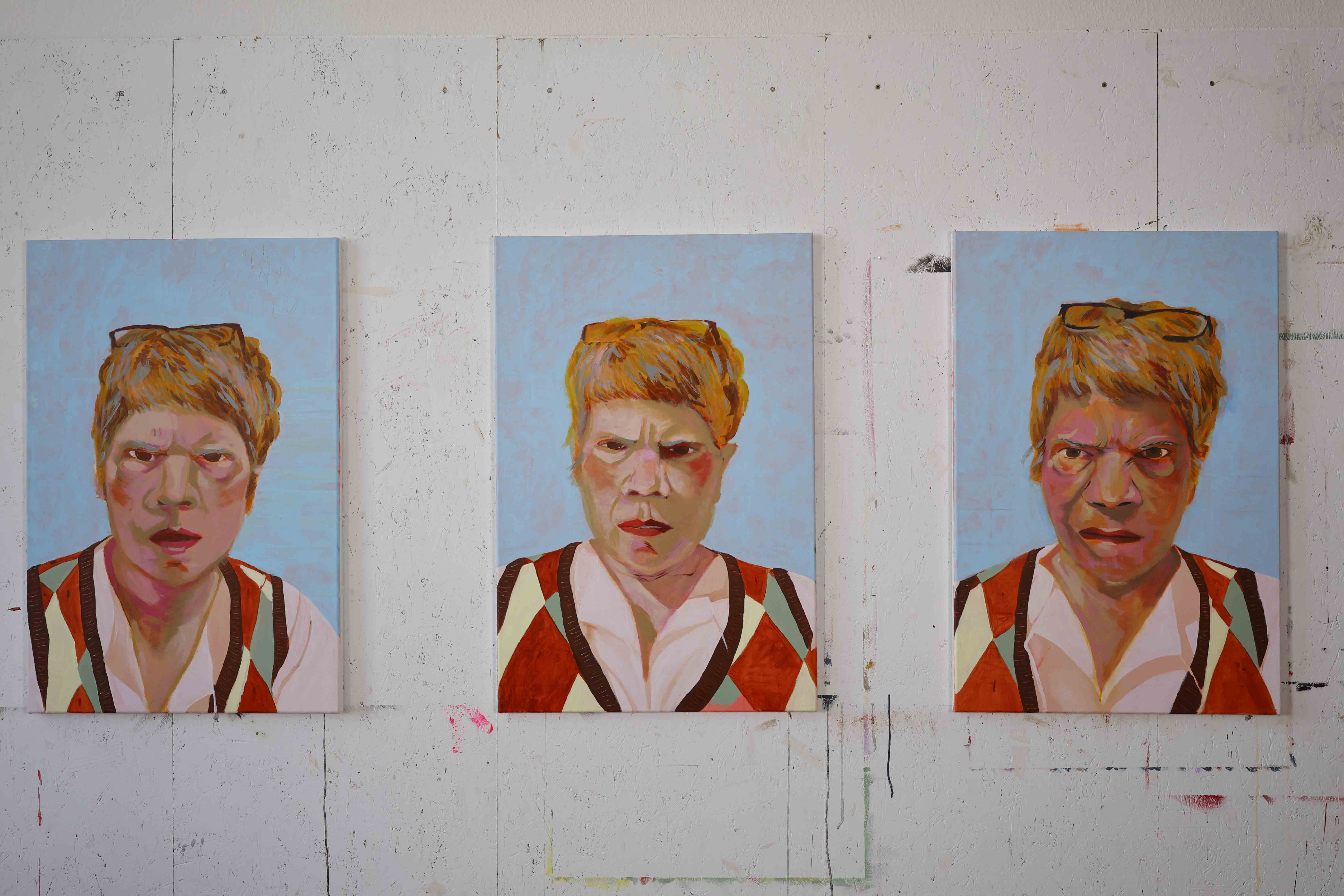
Sandra Stops: Katia – triptych from the series Unveiled Fury: An Ode to Women’s Anger, 2023
The biggest challenge, without a doubt, is balancing family life and work. There’s never enough time to work in the studio undisturbed and without limits. The creative process has its own magic and its own timing – and neither follows external pressure or a packed schedule of obligations.
Another big challenge is showing up as myself. It’s so much easier to hide behind the work. It takes courage to push past my own hesitation and insecurity and to be visible as a person, too.

Sandra Stops: SHARED SORROW III, 2021, mixed media on paper, 70 x 100 cm

Sandra Stops: SHARED SORROW I, 2021, mixed media on paper, 100 x 70 cm
Interaction with other creatives and artists is incredibly important to me! Whether through personal exchange or across centuries via a book – these are invaluable connections that help in so many ways. Conversations and collaborative projects spark new ideas and offer different perspectives. Staying in touch with others helps me reflect on and develop my own work.
That said, there are always phases in my process where I need complete solitude. In those moments, I don’t even want visits from close friends!
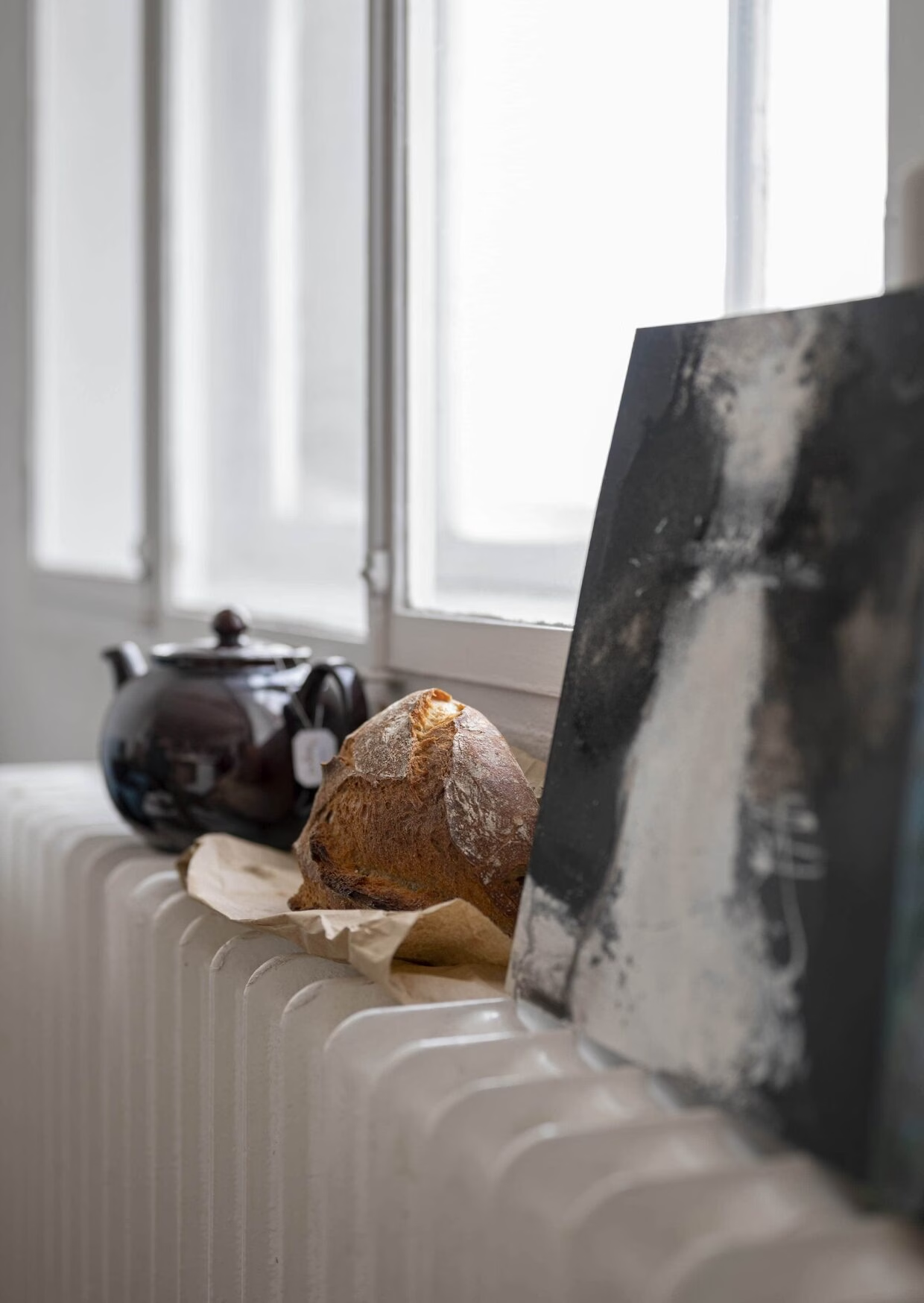
Tea and good bread matter | Photo: Paula Lüdke
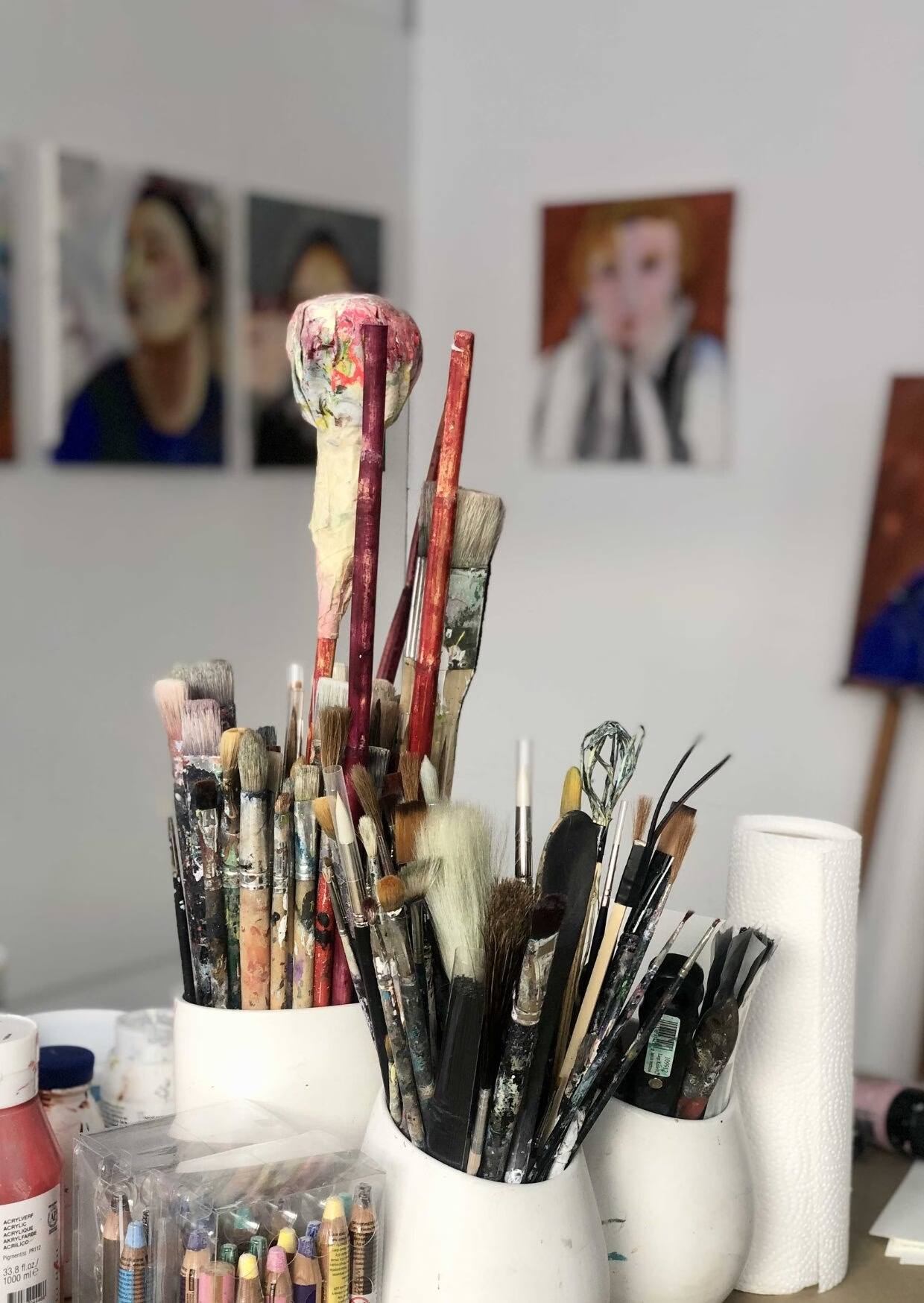
Brush selection in the studio
Art, to me, is much more than a beautiful painting or an aesthetic object. It’s a way of understanding myself better, questioning the world around me, and opening space for dialogue. When I’m working artistically, I’m constantly transforming ideas, reflecting on thoughts, observing myself and the process, questioning things, reshuffling perspectives, discovering new parts of myself, and gaining fresh insights.
Marina Abramović once said, in essence, that art is an encounter – a dialogue in which both the artist and the viewer discover themselves. That resonates deeply with me. I see art as a space for intense, personal, and transformative experiences. But it’s also a mirror of societal dynamics and plays a fundamental role in my life – not only because it helps me grow, but because it encourages us to critically reflect on the conditions we live in.

Photo: Paula Lüdke
As I mentioned before, art can be a mirror for societal developments and problems. Artists can draw attention to imbalances, act as catalysts for change, and invite us to adopt different perspectives – to look at things from another angle. I believe it’s incredibly important to keep questioning ourselves and our assumptions.
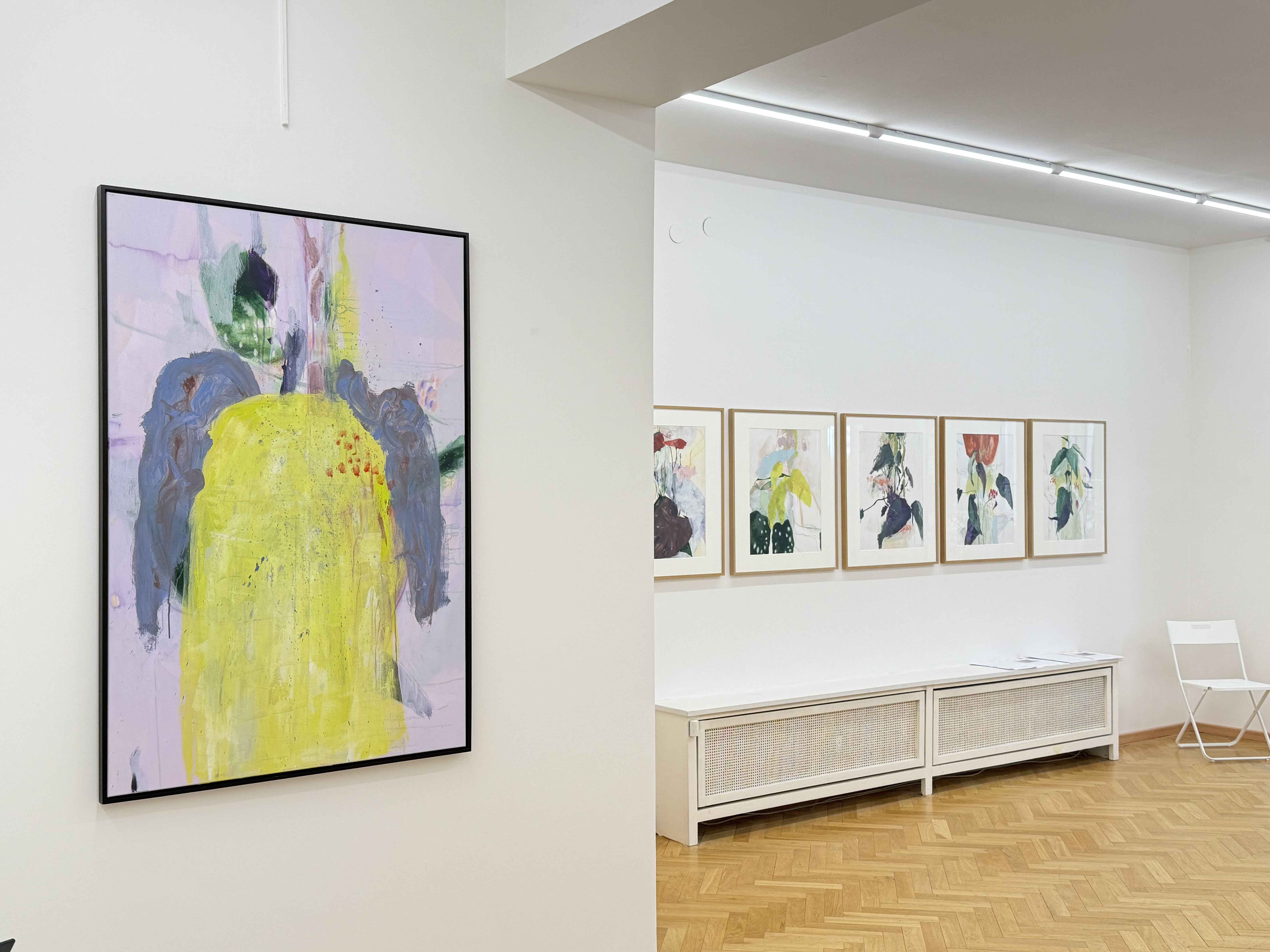
Exhibition "An den Adern des Lichts", TAA Galerie Berlin, February 2025
There are two central questions that guide my painting – and really my whole life: Who are we as human beings? And how do we want to relate to one another?
Asking questions about life and entering into dialogue with others feels meaningful, enriching, and inspiring to me – even essential. I always imagine people standing in front of my work, accepting an invitation to engage – whether with the artwork or with themselves. When someone feels moved by one of my pieces, I find that truly beautiful.
Thank you, Sandra!
If you're an artist or creative – whether you work in painting, music, literature, or any other form of art – and you'd enjoy sharing insights into your work and creative process, feel free to get in touch!
I’m excited to use this interview series to highlight the diversity of creative expression and to learn from your perspectives and experiences.
Join the newsletter now
and not miss a thing
Get exclusive insights into my creative processes, learn the stories behind my artwork
and receive invitations to my exhibitions and events.
To say thank you, I'll give you 10% off your first purchase.